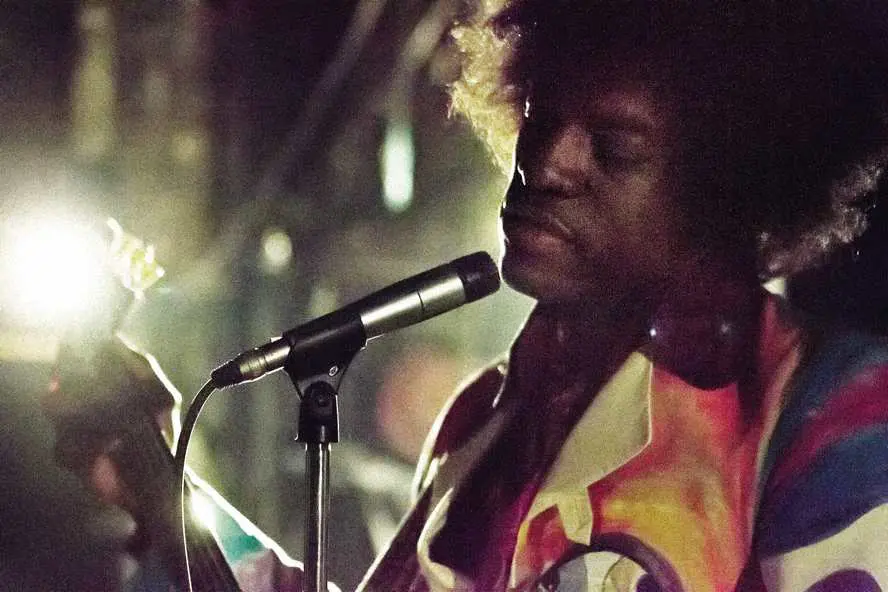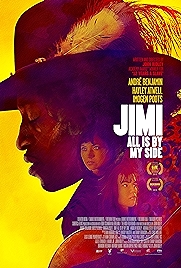Here’s a problem for anyone about to make a film about Jimi Hendrix, genius guitarist, 1960s icon, member of the 27 Club of rock’s premature expirers – how do you get inside a character who was private, taciturn, shy and elliptically cool? With a voiceover? A confidant? Newsreel footage? It’s a question that writer/director John Ridley answers with a shrug in this inert biopic which fails to locate Hendrix in his time.
There’s another problem too. Hendrix died a long time ago now. Hell, even Kurt Cobain died a long time ago now, so Ridley needs to make a film that tells an audience who might know next to nothing about Hendrix why and how he was the world’s greatest guitarist.
I say “the world’s greatest guitarist” because I’m of an age to know almost all of his music note for note. Growing up, we even had records in our house made by Hendrix before he was famous, when he was a jobbing musician with Curtis Knight and the Squires (I think – it was a while ago).
And that’s where the film picks up Hendrix (André Benjamin of Outkast), in 1966, in a backing band playing tasty guitar licks of a fairly unambitious sort in a New York club. In the scant crowd was Linda Keith (played by Imogen Poots), a former girlfriend of Keith Richards with a rich daddy, an eye for talent and a fair bit of time on her hands. Ridley’s film then follows Hendrix for the next year, as Linda Keith introduces Hendrix to the world of rock she knew, connects him up with Chas Chandler (an outstanding Andrew Buckley), the Animals’ bassist who became Hendrix’s manger. And it leaves him just as Jimi is about to play the 1967 Monterey Festival, where Jimi (and his Ronsonol-doused guitar) caught fire.
This is your “Star Is Born” story, in other words, though here it’s Hendrix’s enormous luck in meeting Linda Keith rather than his enormous talent that gets him the shot at stardom.
If Ridley doesn’t get his man, he does get his music and the film’s standout moments all occur on stage. First when Keith sees Hendrix in New York, then when Hendrix almost forces himself on stage to jam with the Cream, and so frightens guitarist Eric Clapton (known at the time simply as God) with his prowess that Clapton dashes from the stage. And finally when his band The Jimi Hendrix Experience plays at the Saville Theatre, where the Beatles are in the audience, and cheekily opens with the first track off their new Sergeant Pepper album, released only a couple of days before.
Much has been made of the fact that no actual Hendrix music – ie songs written by Hendrix – was used in the film. But it doesn’t matter a bit. For a start Hendrix did plenty of covers – Hey Joe, All Along the Watchtower, Red House, Johnny B Goode among them – and the backroom team (guitarist Waddy Wachtel, bassist Leland Sklar, drummer Kenny Aronoff) have enough talent and confidence not to make this a note-for-note recreation of the records. But never mind who or how or why, the music satisfies the ultimate arbiter – the hairs on the back of the neck.
As for the rest of it, it’s a competent and routine rock biopic – getting the band together, the girlfriend, backstage, frontstage, with Ridley occasionally remembering it was the 1960s and throwing in a couple of seconds of psychedelic montage.
Probably the third question you’d ask going into the film, if you knew it was Ridley in the driving seat, is how is the writer of 12 Years a Slave going to handle the race thing? In two eminently cuttable scenes he answers it – first as Hendrix is hectored and belittled by a trio of loutish coppers, who are ostensibly angry that he’s wearing a British military jacket in a disrespectful fashion. Second in a scene between Hendrix and Michael X, Britain’s embarrassing counterpart of the US’s Malcolm X, in which the revolutionary mini-me encourages Hendrix to be, in short, more black. Hendrix responds with something about the power of love beating the love of power, in that maddening drawl beloved of rockers to this day, but which marks Hendrix out as being in the vanguard of post-racial politics, and music.
As for the dolly birds, they really do get the rough end of the pineapple. Poots as the well heeled Linda Keith getting almost reverential treatment as the girl who made it all possible but was absolutely definitely and quite categorically not a groupie. Hayley Atwell plays a blinder as the girl who steals Hendrix off Linda Keith – a heart of gold, a body of honey, talons of dripping venom (see Coronation Street’s 1960s siren Elsie Tanner for where at least 75% of her remarkable performance comes from). As for the rest of the women, they gabble and caw at the edge of the frame like a ravening mob of low-rent courtesans. Adherents of the “class, race, gender” school of film criticism, sharpen your tools.
Which brings us to André Benjamin as Hendrix, who is as good as Jimi as Jamie Foxx was as Ray Charles in Ray, convincing entirely from the first second he appears that he’s the real thing. I certainly never doubted, never saw the performance, from the way Hendrix dipped his head while he talked, to the skinny-cool aura he gave off, Benjamin has it all down. But Benjamin can’t give us something that’s not in the writing and Ridley seems uninterested in filling out who this man is – and isn’t that the point of a biopic? This leads to the film’s potentially most upsetting moment – an outbreak of violence by Hendrix – leading to head scratching rather than shock.
The brilliant character actor Burn Gorman turns up for a couple of minutes, as Hendrix’s co-manager Michael Jeffery, one of those spivvy wheeler-dealers who actually made the 1960s happen, and the screen crackles into life with mendacity, greed and lust. And suddenly there’s a hint of the film that this might have been, a glimpse of a moment when talented young people were ushered into stardom by managerial geniuses who generally stole their money and didn’t give a stuff about the counter culture. Instead we have a disappointing almost-biography which goes only album-cover deep in its explanation of what the 1960s were about and how its brightest star, Jimi Hendrix, fitted into it all.
Jimi: All Is by My Side – Watch it/buy it at Amazon
I am an Amazon affiliate
© Steve Morrissey 2014

